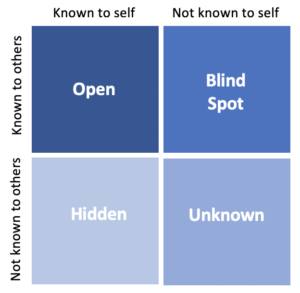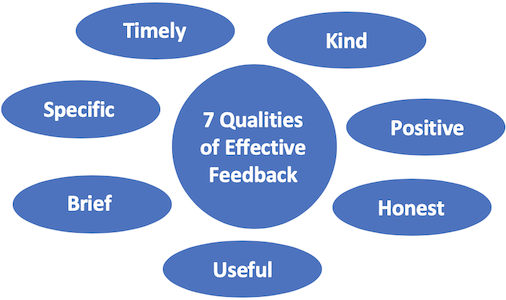Workplace Essentials
Giving & Receiving Feedback
In this chapter you’ll learn why feedback is useful; how to give effective feedback that supports and encourages others; and how to accept and implement feedback to positively impact yourself and your career.
Guiding Questions
As you go through this chapter look for the answers to these questions:
- Why is effective feedback important?
- What seven qualities make feedback useful and effective?
- What’s an easy three-step method for giving feedback?
- What six things can I do to accept and learn from feedback?
Why is Effective Feedback Important?
Effective feedback helps us improve and grow by describing areas for improvement and offering ways to improve.
Being able to give clear, useful feedback is an employability skill. Colleagues and bosses will appreciate your kind, helpful approach to improving teams and processes.
Shows us what we don’t know about ourselves
Things we don’t know about ourselves are called Blind Spots. Effective feedback acts like a mirror, helping us see our blind spots so we can start to improve.
Some blind spots are physical, like speaking too fast. Others are less obvious, like mistakes in our work, or strengths we didn’t know we have.
The Johari Window, shown below, helps us see where effective feedback can be most useful.
Johari Window
The Johari Window1 divides self-awareness into four parts:
- Open: What we know about ourselves, and is also known by others. For example, your name or height.
- Blind Spot: What we don’t know about ourselves, but is known by others. For example, that you speak faster when nervous, or that you describe things really well.
- Hidden: What we know about ourselves, but is not known by others. For example, your thoughts or secrets.
- Unknown: What we don’t know about ourselves, and is not known by others. For example, latent talents.
 Effective feedback helps us see our blind spots and unknown areas. With that awareness, we can then start to correct our weaknesses and develop our strengths.
Effective feedback helps us see our blind spots and unknown areas. With that awareness, we can then start to correct our weaknesses and develop our strengths.
How to Give Feedback
Feedback is useful only when it’s effective. Effective feedback supports and builds; unskillful feedback can hurt and be destructive.
Effective feedback has 7 qualities:
- Timely: Give feedback as soon as possible
- Kind: Help the recipient grow and build skills; don’t embarrass or shame them
- Positive: Tell the recipient what to do, not what not to do
- Honest: Always tell the truth (kindly!), even when a lie might feel more comfortable
- Useful: Make suggestions that are practical and actionable
- Brief: Focus on only 1 improvement at a time – the most important one. (More will confuse the recipient)
- Specific: Be precise and give examples
–
The easy 3-step method
There are many ways to give feedback. This simple 3-step method is easy to remember and use.
- Keep: Start by describing the best part: What’s already good, what does the person do well, what should they keep doing?
- Improve: Describe the most important improvement, and why it’s important. Focus on ‘next time’ or ‘in future.’ For example, Next time, try to let us know before the deadline. That way we can help you before it’s a problem. Or Next time, try to speak louder, so everyone can hear your great ideas.
- Ask: the recipient if they have questions or want more information.
How to Receive Feedback
Most of us have a mean inner critic who yells at us for not being perfect. Receiving feedback triggers this critic, making us feel ashamed or embarrassed. This makes it hard to listen and learn.
When someone offers you feedback, try to silence that inner critic so you can benefit from the feedback. Try this 6-step approach:
–
1. Listen actively.
- Make eye contact with the person giving you feedback
- Take notes (you’ll forget what they said)
- Summarize what they said
2. Be respectful & professional.
- Avoid arguing, defending or explaining. Try to drop your defences and just listen
- Watch your tone, words and body language
- Look for what’s true and what’s useful
3. Ask questions to clarify doubts and get precise details and examples.
For example:
- Can you say more about…?
- Can you explain that further, please?
- What advice can you give me?
- How can I build that skill?
- Where could I learn more about…?
- What do you recommend?
4. Appreciate the feedback.
- See the speaker’s good intentions
- Thank the speaker, show appreciation for their time and energy
- Look for what’s useful in the feedback and how it can help you
5. Reflect & grow.
- Reflect on the feedback and decide your next steps:
- What did you learn?
- How will you use the feedback to improve your skills?
- What will you do next time?
Self-Assessment
Canadian Workplace Quiz
- Joseph Luft and Harry Ingham, “The johari window,” Human relations training news 5, no. 1 (1961): 6-7, http://www.richerexperiences.com/wp-content/uploads/2014/02/Johari-Window.pdf




